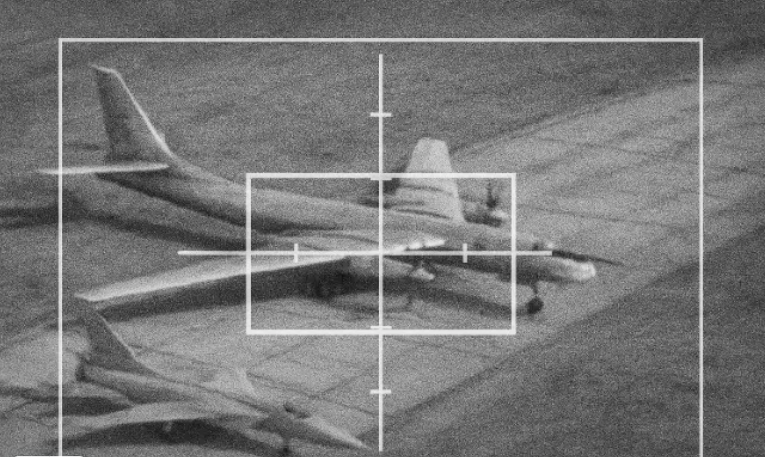For more than a hundred years, airpower was synonymous with height, hierarchy, and hubris. From the first Zeppelin raids in World War I to the massive aerial bombardments of Dresden and Tokyo, the sky was not just a domain—it was a throne. Whoever controlled the skies, it was believed, could shape the earth below. This was the logic of vertical war: a world where strategic might was projected from above, through tightly managed chains of command, million-dollar platforms, and impenetrable sanctuaries.
The United States’ shock-and-awe campaigns in Iraq, Russia’s long-range bomber patrols, and NATO’s relentless air dominance in Kosovo—these were not just military operations, but performances of altitude and order. The very structure of deterrence relied on this model: deep-inland airfields, secure runways, strategic bombers tucked away thousands of kilometers from the front, all forming a choreography of control. From the Cold War’s nuclear triad to today’s stealth fighters, verticality promised safety through superiority.
But history has a habit of humbling even the most confident doctrines.
June 1, 2025: The Day the Sky Fell
When Ukraine launched Operation Spiderweb, striking five Russian airbases across thousands of kilometers, it didn’t just destroy aircraft—it destroyed assumptions. This was not the first time the rear was violated, but the scale, depth, and improvisational method made it unmistakably new. Instead of ballistic missiles or airstrikes from sovereign territory, the Ukrainians used drones smuggled in wooden cabins, transported by trucks, launched remotely, and steered through the seams of Russian air defense networks—exploiting gaps not just in radar coverage, but in imagination.
These weren’t random targets. The bombers destroyed in Spiderweb—Tu-95MS Bear-Hs and Tu-22M3 Backfires—were not just aging aircraft, but symbols of Russia’s strategic airpower doctrine, dating back to the Cold War. For decades, they had been stationed deep in the Russian interior, beyond the perceived reach of adversaries. These bombers were central to both nuclear deterrence and long-range precision strike capability, particularly in Syria and Ukraine. In Moscow’s doctrinal logic, they were the “Sunday punch”—the arsenal of last resort that would guarantee strategic equilibrium.
But Spiderweb tore through this illusion. The damage was staggering. Ukrainian sources claim over 40 aircraft were damaged or destroyed, with independent analysts confirming the loss of roughly one-third of Russia’s operational long-range bomber fleet. Satellite imagery revealed craters across hardened aircraft shelters, burned-out fuselages, and extensive secondary explosions—testament to fuel and munitions igniting on impact. Conservative estimates put Russia’s losses at over $7 billion USD, a blow not just to military capacity but to national prestige.
The Russian reaction was swift—but telling. Within hours, state media downplayed the scale of the attack, citing “minor damage” and blaming internal sabotage. Meanwhile, Telegram channels linked to military insiders told a very different story—of command confusion, scrambling air defense crews, and panicked attempts to relocate strategic assets further east. The Ministry of Defense launched investigations into the apparent failure of counter-drone systems, while also ramping up patrols around key installations in Siberia and the Far East. Notably, Russia began repositioning strategic bombers to more dispersed civilian airports, implicitly acknowledging that hardened military bases had become predictable—and therefore vulnerable—targets.
Internationally, the shockwaves spread quickly. NATO officials privately expressed alarm, not at Ukraine’s capabilities, but at the precedent: if Ukraine could do this to Russia, what might a non-state actor or rogue regime do to NATO’s own deep-inland assets? Discussions intensified around the vulnerability of fixed airbases in Germany, Turkey, South Korea, and Guam. U.S. Air Force planners accelerated efforts to implement the Agile Combat Employment (ACE) doctrine—dispersing forces, using civilian airports, and preparing for operations in contested rear areas.
In Beijing, the PLA’s strategic community took note. Chinese military thinkers, particularly those studying Taiwan contingencies, began reassessing the survivability of their own bomber fleet—the H-6Ks—stationed at similar depths within the mainland. A key takeaway emerged: strategic depth is no longer geographical—it is behavioral, architectural, and informational.
And for Ukraine, Spiderweb was more than just a strike—it was a doctrinal announcement. Kyiv showed that distributed, deniable, and cheap systems could achieve what expensive cruise missiles often could not: parity through proliferation, not through parity of force. The vertical model—based on centralized command, exquisite platforms, and layered defenses—began to look brittle in a world of horizontal improvisation and persistent disruption.
A Historical Reversal: From Pearl Harbor to Spiderweb
This isn’t the first time military orthodoxy was upended by surprise. History offers several moments when technological innovation, combined with operational daring, shattered prevailing doctrines and forced a complete rethinking of warfare.
Pearl Harbor (1941) marked the end of the battleship era. The Japanese, using six aircraft carriers launching over 350 planes, struck at what was then considered untouchable: America’s Pacific Fleet anchored at Pearl Harbor. Within hours, eight U.S. battleships were damaged or sunk. But the real impact was doctrinal: the centerpiece of naval power—the heavily armored battleship—was exposed as a sitting duck against fast, long-range air strikes. Overnight, the aircraft carrier, once viewed as a supporting asset, became the core of U.S. naval strategy. The vertical model of sea dominance—based on concentrated firepower and static defense—was replaced by mobile strike groups and power projection through air wings.
The 1973 Yom Kippur War offers another doctrinal shock. Israeli defenses, long reliant on the air superiority gained in 1967, were caught off guard when Egyptian forces crossed the Suez Canal under a dense umbrella of Soviet-supplied SA-6 surface-to-air missiles, while Syrian troops in the Golan Heights used Sagger anti-tank guided missiles to devastating effect against Israeli armor. The assumption that air supremacy alone could ensure battlefield dominance was shattered. In just days, more than 100 Israeli aircraft and scores of tanks were lost. The lesson was clear: integrated air defenses and precision-guided munitions could erode even the most technologically advanced force if that force failed to adapt its posture and assumptions.
Operation Spiderweb stands squarely in this lineage of doctrinal disruption—but introduces something even more destabilizing. It is not only a surprise attack, but a demonstration of horizontal warfare—a new method of waging war that challenges the vertical hierarchies upon which modern militaries have been constructed. Where Pearl Harbor and the Yom Kippur War relied on national air forces and state-level military-industrial platforms, Spiderweb showcased decentralized drone teams, remote operators, and mobile, concealable launch platforms. The tools were not massive ships or state-of-the-art jets, but wooden trailers hiding autonomous drones, maneuvered into position across thousands of kilometers and launched with real-time targeting from commercial satellite feeds.
In this respect, Spiderweb is not just a moment of surprise—it is a turning point in the architecture of war itself. It signals the rise of cheap, agile, distributed lethality—a warfare model where dominance comes not from altitude or armor, but from networked systems, deception, and scale-free disruption.
The Horizontal Turn: Flat, Fluid, and Fragmented
In contrast to vertical war, horizontal war-making is dispersed, lateral, and improvisational. It does not seek dominance through altitude, massed firepower, or centralized command. Instead, it infiltrates from all sides—swarming, distracting, degrading, and overwhelming through fragmentation rather than consolidation. Its arsenal is not composed of majestic aircraft carriers, stealth bombers, or hardened command bunkers, but of networked drones, portable launch systems, off-the-shelf electronics, and open-source intelligence tools like commercial satellite imagery and publicly available terrain data.
Where vertical war invests in layered air defenses and assumes the sanctity of rear zones, horizontal war assumes permeability—that no zone is truly safe and no perimeter is impervious. It is decentralized by design, not by necessity. Instead of battalion formations or strike packages, it uses mesh networks of autonomous or semi-autonomous systems—cheap, scalable, and, critically, expendable.
This form of war is intellectually and tactically closer to guerrilla logic than to conventional state-centric warfighting. It draws from asymmetric traditions that span centuries. One can trace its genealogy to Ho Chi Minh’s tunnel systems in the Vietnam War—vast, hidden networks from which Viet Cong fighters could appear and disappear at will, undermining a technologically superior foe through sheer invisibility and persistence.
It also echoes Mao Zedong’s dispersed militia strategy, which stressed political resilience, local control, and the strategic use of time—waiting out the enemy’s strength and exploiting their logistical overreach. More distantly, it recalls the Mongol horse archers of the 13th century, who traveled light, struck swiftly from unexpected directions, and dissolved into the steppe before conventional armies could respond. The Mongols didn’t fortify—they flowed.
The difference is that today’s guerrilla logic is digitally supercharged. The new Mongols don’t ride horses—they drive unmarked trucks carrying drone pods. Their arrows are crafted from 3D printers, guided by GPS, and often launched via automated software linked to real-time reconnaissance. A drone operator sitting in a nondescript container 500 kilometers away can execute a strike once possible only with an entire air wing.
As military theorist Thomas Mahnken emphasizes, survivability in the 21st century is no longer about being the strongest or the most armored. It’s about being everywhere and nowhere at once—a logic of survivability through dispersion, deception, and mutability. In horizontal war, the battlefield is not a fixed geography—it is a fluid architecture of signals, systems, and fleeting presences. Victory is not claimed by occupying ground but by making the enemy’s power projection untenable, unsustainable, and psychologically disorienting.
Conclusion: The Sky Is No Longer the Limit
Operation Spiderweb was not just a strike—it was a warning. It said to Russia, and to the world, that no sanctuary is sacred, no distance safe, no doctrine immune. It transformed the strategic rear into contested space and the battlefield into a fluid, interconnected web of possibility and peril.
The vertical era gave us the illusion of control. The horizontal era offers only contest—persistent, unpredictable, and deeply human in its ingenuity. The war of the future may no longer be fought between towers in the sky, but across the flatlands of cyberspace, logistics, and innovation.
There is also something deeply human—almost revolutionary—about this transformation. For centuries, only the richest empires could afford air dominance. Today, the tools of strategic disruption can be assembled in a garage, launched from a truck, and guided by a teenager with a laptop. This is not just a redistribution of firepower; it’s a revolution in agency.
The monopolies of violence held by great powers are being challenged by a new, flatter battlefield—one where non-state actors, mid-tier powers, and the creatively desperate can compete with behemoths. The shift is not only military but moral: what happens when war is no longer choreographed from command centers, but improvised in fragments and relayed through encrypted networks?
In this new world, power will not belong to the biggest machine or the highest altitude—but to those who can think fastest, move widest, and survive longest in a battlespace that has lost its ceiling.







